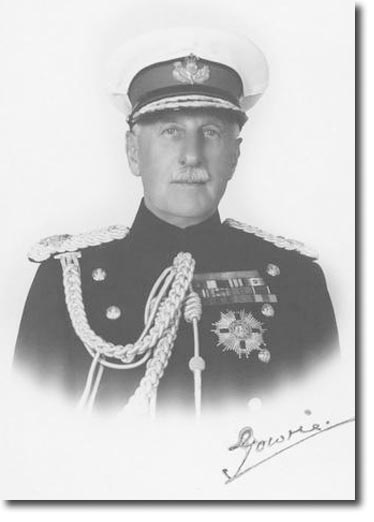|
|

 |
|
Alexander Gore Arkwright Hore-Ruthven was born at Clewer in Berkshire on 6 July 1872. His father was Walter James Hore-Ruthven, 9th Lord Ruthven of Freeland. His mother was Lady Caroline Annesley Gore, daughter of the 4th Earl of Arran. He was educated at Winton House School in Winchester, and at Eton and Haileybury. He first went into business in tea importation, travelling to India where he caught malaria and had to return in 1892.
His military career began in the Lanarkshire Yeomanry, but in 1893 he joined the 3rd Bn Highland Light Infantry and went to Egypt and Sudan for the Mahdist War. He was mentioned in despatches and also earned the Victoria Cross. On 22 Sep 1898 Captain the Honourable Alexander Hore-Ruthven, at Gedarif, seeing an Egyptian officer lying wounded within 50 yards of Dervishes, who were firing and charging, picked him up and carried him towards the 16th Egyptian Battalion. He dropped the officer 2 or 3 times and fired at the enemy who were following. Had the officer been left where he first fell he would certainly have been killed. On 17 May 1899 he gained a regular commission as a 2nd lieutenant in the Queen’s Own Cameron Highlanders. He had been a captain in the 3rd militia battalion HLI so had to drop two ranks. In Nov 1899 he was in the Camel Corps in the force fighting the Khalifa, and he fought in Somaliland in 1903-4. He was ADC to the 2nd Earl of Dudley, Lord Lieutenant of Ireland from 1902 to 1905. He joined the KDG on 1 April 1908 as a supernumerary captain but did not stay with them long as the Earl of Dudley was appointed Governor-General of Australia, and Captain Hore-Ruthven went with him as military secretary. In 1910 he travelled to India for military service with the KDG. During World War One he earned the DSO twice. He was wounded at Gallipoli and mentioned 5 times in despatches. He served in France and earned his second DSO for leading his brigade east of Ypres from 27 Sep to 28 Oct 1918. The citation said ‘On 20 Oct, at St Louis, he went forward among the attacking troops at a critical juncture and inspired them to the final effort, whereby the high ground of great tactical value was captured.’ After various staff positions he was appointed Governor of South Australia in May 1928. He was an enthusiastic governor, visiting the State in a plane owned by his ADC Hugh Grosvenor. He was involved in the scouts and the Red Cross. He found himself in trouble when he criticised the Trade Unions for making life difficult for returned servicemen. He supported the Lionel Hill government during the Great Depression in the 1930s. His term of office ended in 1934 and he was moved to New South Wales. He was appointed Governor-General of Australia in 1936 just after George V died. He was the first Governor-General to make a foreign tour when he went to the Netherlands East Indies in 1938. He was involved in the choice of PM when Joseph Lyons died in April 1939 and became embroiled in a crisis after the 1940 election, and he persuaded the coalition government to have John Curtin as PM. During his time in office he worked with 5 Australian Prime Ministers. His wife was well-known for her work in promoting the welfare of children. In December 1942 Lord Gowrie went on a 4-week tour of inspection of Allied Defence Forces in northern Australia and New Guinea. He ended his term of office in Sept 1944. On his return to the UK he was created 1st Viscount Ruthven of Canberra and of Dirleton in the County of East Lothian, and 1st Earl of Gowrie. He was also lieutenant-governor of Windsor Castle. Hore-Ruthven was married on 1 June 1908 to Zara Eileen Pollok from an Irish family who became the Countess of Gowrie. They had two sons, one of whom died in infancy in 1918 and the other, born in August 1913, was an officer in WW2 who was sadly killed on 24 December 1942 while leading a commando raid in Tripoli, aged 29. The Earl of Gowrie died at his home, at Shipton Moyne in Gloucestershire on 2 May 1955, and was buried at St John the Baptist Church, Shipton Moyne.
1889 Commissioned into Lanarkshire Yeomanry. 19 Oct |
Armed Forces | Art and Culture | Articles | Biographies | Colonies | Discussion | Glossary | Home | Library | Links | Map Room | Sources and Media | Science and Technology | Search | Student Zone | Timelines | TV & Film | Wargames